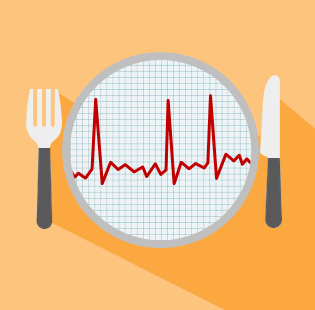It’s a question many people ask, and for good reason—every 37 seconds, one person in the U.S. dies from heart disease. It’s never too early—or too late—to take steps toward minimizing your risks.
Your likelihood of developing heart disease is determined by both your medical history and your lifestyle choices. Here are 8 conditions that strongly influence your risk:
Family History of Heart Disease
The more family members with a history of heart disease, and the younger they were at the time of their diagnosis, the greater your “inherited” risk. For example, your risk due to family history is much greater if your parent or sibling had heart disease at age 40 than if your grandparent had a heart problem at age 72.
Diabetes
Diabetes an especially strong risk factor—so much so that a diabetic’s risk of a future heart problem is considered the same as someone who has previously suffered a heart attack. Diabetes is diagnosed when the fasting sugar (glucose) level is 126 mg/dl or greater on more than one day.
“Prediabetes”, defined as repeated fasting glucose measurements between 100 and 125 mg/dl, is also of concern as some studies suggest levels in this range are associated with increased risk of vascular disease. In addition, those with prediabetes clearly have a significant chance of progressing to full diabetes.
High Blood Pressure
High blood pressure is defined as repeated readings of 140 or greater for the top number (systolic) or 90 or greater for the lower number (diastolic).
High LDL Cholesterol
LDL is known as “bad” cholesterol—it’s the fat most responsible for plaque buildup in the arteries. Levels under 130 are best for most people. Tighter control is needed for people with diabetes or history of blocked arteries (when LDL should be at least under 100 and best under 70).
Low HDL Cholesterol
HDL is the “good” cholesterol—it’s your body’s garbage collector, scooping up the excess LDL and eliminating it. You want to have enough garbage collectors to keep the “pavement” of your arteries clean—levels should be above 40 for men and above 50 for women.
To learn more about different types of cholesterol, check out our module on dietary fat.
Smoking
Smoking is the strongest controllable risk factor. If you smoke and want to concentrate on only one area, make quitting your #1 goal.
Waist Circumference
A waist measurement of over 35 inches for women and 40 inches for men puts you at increased risk. To take your measurement, circle a tape measure around your waist just over your hip bone. Not only does the extra weight pose a burden to your heart because your heart has to pump harder, but excess belly fat is actually a ‘factory” of inflammatory chemicals that irritate the blood vessels.
Lack of Sleep
What constitutes “too little” sleep? The number varies from person to person, but generally less than 7 hours per night. Lack of sleep puts excess strain on your body, and contributes to weight gain, high blood pressure, and an increased risk of heart attacks.
Those with sleep apnea are at especially high risk. Signs of sleep apnea include excessive snoring, always feeling tired even after a long period of sleep, and falling asleep during the day when you are not trying to sleep. If you have these symptoms, your doctor may order a sleep study to confirm the diagnosis.
Monitor these 8 conditions—and control them wherever possible—and you’ll drive your heart-disease risk down.
Reference: Heart Disease Facts by the CDC
Interested in living a healthier lifestyle?
Learn the essentials of eating and living healthfully in our interactive, user-friendly learning program for the public.
Clinicians: Do you feel confident responding to patient questions about nutrition?
Take our award-winning condensed interactive nutrition CME—and learn what every clinician should know about nutrition.



